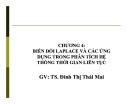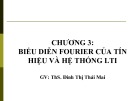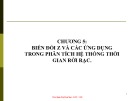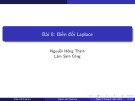
TÍN HIỆU NGẪU NHIÊN
Định nghĩa
Tín hiệu không đóan được trước khi nó xuất
hiện
Không thể mô tả bởi biểu thức tóan học
Được mô tả bằng lý thuyết xác xuất
Được gọi là “quá trình ngẫu nhiên”
Quá trình ngẫu nhiên gồm một số hữu hạn các biến
ngẫu nhiên
Ví dụ:
( ) 5 c o s ( 2 ), w h e r e is r a n d o m
c
x t f t
CuuDuongThanCong.com https://fb.com/tailieudientucntt

1.5 Random Signals
1.5.1 Biến ngẫu nhiên X(A)
Biến ngẫu nhiên là một đại lượng thực mà trị của nó phụ
thuộc vào biến cố ngẫu nhiên. (để biến cố NN có thể được
mô tả một cách định lượng)
Ví du độ lệch của viên đạn so với mục tiêu là một đại lượng
phụ thuộc vào kết qủa của lần bắn.
Sự phụ thuộc này được được biểu diễn bởi quy luật xác
suất gọi chung là phân bố
Sự phân bố của biến NN được mô tả bởi hàm mật độ xác
suất PX(x).
2
1
-
12
. n o n -n e g a t iv e : ( ) 0
. n o r m a li z e d : ( ) 1
. e v e n t p r o b a b i li ty : ( ) = (
2
)
1
3
X
X
x
X
x
px
p x d x
P x X x p x d x
CuuDuongThanCong.com https://fb.com/tailieudientucntt

Discrete pdf
has the same properties (change integration to summation)
Two important random variables and their pdf
()
i
p X x
01
(
. U n if o r m r a n d o m v a r i a b le
1
continuous ( ) , for
1
discrete: ( ) , for { , , }
. G a u s s i a n ( n o rm a l) r a n d o m
1
2v a r i a b le
1
( )
2
X
iM
xm
X
X
p x a x b
ba
p X x X x x
M
p x e
2
2
)
2
X
X
CuuDuongThanCong.com https://fb.com/tailieudientucntt

Các thông số
Example:
Data bits are modeled as uniform random variable with two values
Symbols are modeled as uniform random variable with M values
Noise is modeled as Gaussian random variable with zero mean and
non-zero variance
2 2 2 2
. m e a n : { } ( )
. v a r ia n c e : { ( ) } { }
(variance = m ean sq
1
2
u a r e v a lu e - m e a n v a lu e s q u a r e )
XX
X X X
m E X x p x d x
E X m E X m
CuuDuongThanCong.com https://fb.com/tailieudientucntt

1.5 Random Signals
1.5.2 Random process: X(A,t)
Là một hàm hai biến A, t time-domain signal waveform with
some random event
Usually written as X(t) by embedding A
Stationary random process
Average parameters do not depend on time
We consider stationary random process (signal) only
Can usually be described conveniently only by average parameters
event time
S ta tio n a r y
. m e a n : ( ) { ( )} c o n s ta n t
. a u to c o r r e la tio n (s t a tio n a r y c a s e ) :
1
2 ( ) { ( ) ( )}
XX
X
m t E X t m
R E X t X t
CuuDuongThanCong.com https://fb.com/tailieudientucntt













![Trắc nghiệm Mạch điện: Tổng hợp câu hỏi và bài tập [năm hiện tại]](https://cdn.tailieu.vn/images/document/thumbnail/2025/20251118/trungkiendt9/135x160/61371763448593.jpg)












